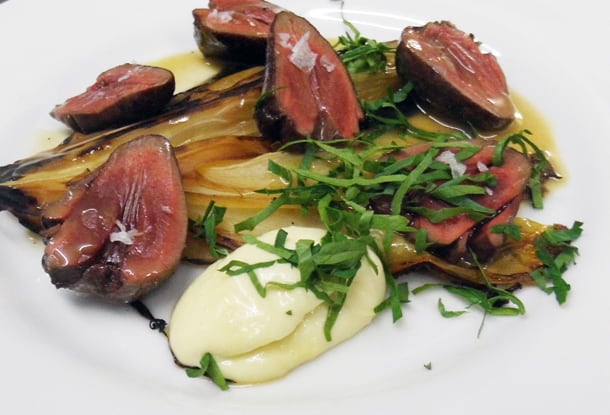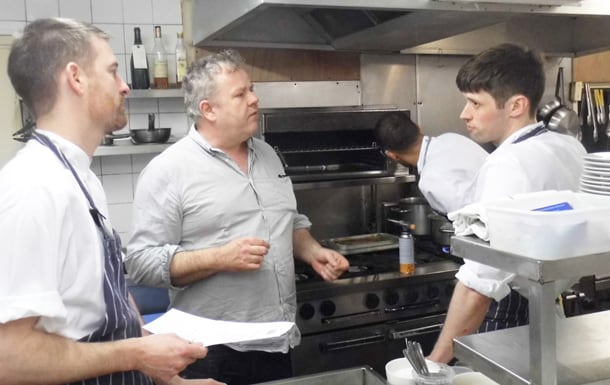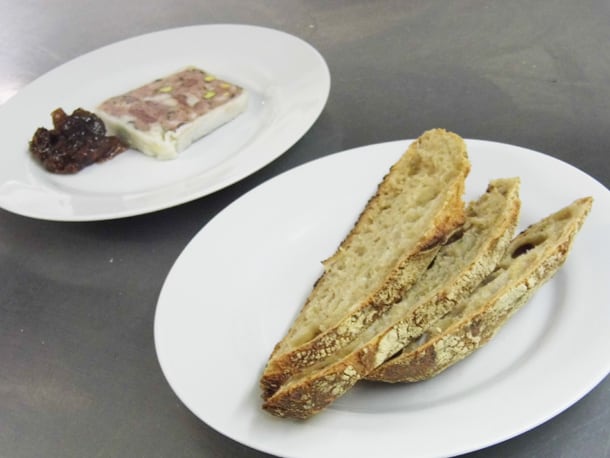Harris, the chef responsible for one of the most revered pubs in the country – the Michelin-starred Sportsman, in Kent, which came first in this year's Top 50 Gastropubs awards – has been working as a consultant chef for the new London wine bar and restaurant Noble Rot, and has come up to the capital to oversee the site’s food offer throughout its soft launch.
The site, on Lambs Conduit Street in Bloomsbury, is the brainchild of wine obsessives Mark Andrew and Daniel Keeling, who recently decided to transpose their cult wine magazine (also called Noble Rot) into bricks and mortar.
Punk
“Dan is married to my cousin,” Harris explains. “He and Mark started the magazine and I absolutely loved it and thought it was the best thing that had happened in the world of wine for a long time, because I always felt the world of wine was run by fussy old men. Noble Rot felt like punk.
“He told me they were going to do a wine bar,” he says. “And then they found a f****** restaurant and things all grew a lot bigger.”
Whilst the press have described his role with Noble Rot as executive chef, Harris doesn’t agree this is the case, maintaining that he is simply there to guide and support head chef Paul Weaver, with whom he has designed the menu.

Weaver worked with Harris at the Sportsman from 2007 to 2012 before moving to Fergus Henderson’s St John Bread & Wine, in Spitalfields.
“Paul was part of our [Michelin] star-winning team,” says Harris, adding that Weaver is one of the chefs who he has always thought to have great potential.
“But I’ve always said young chefs need an editor,” he adds. “They need someone a bit older – a mentor, if you like – so they don’t get carried away with things and go down blind alleys. Keep focused on what’s important, which is good, solid, tasty food.”
Dream place
Harris is massively excited about the Noble Rot’s wine list, clearly wanting it to be the star of the show. “It’s insanely good,” he says. “And I’ve been a collector of wine for 20 years – I’ve never seen anywhere in England or even Paris where you wander in and see names like Raveneau on a wine bar list. For me, this is my dream place.”
But his way of ensuring that wine remains in focus, it becomes clear, has been to create a menu with Weaver that constantly and creatively references wine culture and theory, the same way the Sportsman references the social and agricultural history of its location.
“The Sportsman is sat in the middle of all these fantastic ingredients that have been there for a thousand years and is in the doomsday book as being the larder of Canterbury cathedral – you’d be an idiot if you didn’t refer to that or allow that to inform your food,” he says.
Ideology
At Noble Rot, this ideology is most present in dishes such as Oyster Raveneau, which Harris says was designed to taste like drinking a glass of Chablis.
“[The dish] is based on those tasting notes where someone waffles on about being able to taste sea air and crushed oyster shells in wine, you know ‘I’m getting oyster shells and wet dog ‘ and all that stuff,” he laughs.
“The idea was that I would take all those crazy tasting notes and make an oyster that reflected that, but then I remembered that Chablis is grown on old oyster shells.”
He explains: “The oyster acts as the spine and then there’s apple granita, which is nice and cold like a glass of wine should be and the malic acid comes from the apple – which young Chablis often comes to taste of.”

Following the granita, a touch of apple vinegar is added ‘to boost tanginess’ as well as a few drops of lemon, brown butter and seaweed powder.
“The brown butter represents the hazelnut taste that you get from old barrels rather than new barrels, which is what Raveneau uses. Butter is one of the characteristics of Chardonnay and the seaweed powder gives it the smell of the sea on a wet day in winter.”
Theory
If you put that all together, he says, in theory you will have the taste of a glass of wine. And Harris is eager to extend this practice further with Noble Rot’s menu.
Take the kitchen’s turbot braised in oxidised 1998 Bâtard-Montrachet Grand Cru, for instance.
Over the last decade, Burgundy wines like Montrachet have been suffering from a mysterious blight – Keeling describes the way some collectors have been dismayed to find, out of a case of twelve bottles (which can cost up to £300 each depending on producer) that four or more have unexplainably oxidised, or ‘completely screwed’ as he puts it.
“I am one of the people who bought a case of Puligny-Montrachet. I would open these wines and they were totally screwed, there was no comeback. It drives you mad,” says Harris.
However, the chef’s ‘eureka’ moment came when he decided to try braising turbot in the oxidised wine – essentially reincarnating it as an ingredient. “It turned into a stunning dish,” he says.
Obsession
And he plans to keep incorporating wine into the site’s menu, mentioning the possibility of creating a Vin Santo ice cream and further building on the Anglo-French theme, as well as introducing wine and food tasting menus.
But whilst the food on offer is of a high standard, it's priced considerably lower than you would expect to find was the case at an inner-city eatery, with oysters costing around the £3 mark and the majority of dishes ranging from £8 - £18.
These prices, whilst not permanent, Harris explains, have been set to test the water and can be adapted based on how well the site performs over the near future.
Establishments that set out to charge overambitious sums of money without experience of the market they operate in often fail to maintain a steady footfall, he suggests.
Ultimately, Noble Rot represents the meeting of two obsessions – Andrew and Keeling’s relentless passion for wine and Harris’s irrevocable fascination with food. It’s a whole new playground for the three of them.
Harris finishes: “Slowly more things will happen. It’s going to evolve a lot. We have to reference wine as much as possible and then we have to make great wine and food combinations. That’s how it’s going to move forward.”

